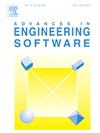Stress intensity factor evaluation for non-planar cracks using virtual grid stress recovery (VGSR) and interaction integral methods
IF 5.7
2区 工程技术
Q2 COMPUTER SCIENCE, INTERDISCIPLINARY APPLICATIONS
引用次数: 0
Abstract
This study proposes a straightforward method for computation of stress intensity factors (SIFs) for three-dimensional cracks featuring curved crack fronts and curved crack surfaces, without concerning the mesh topology around a crack tip. The key idea is to utilize a virtual grid-based stress recovery (VGSR) method on arbitrary nonplanar crack geometries along with the interaction energy integral to extract SIFs correspond to different modes. Since the VGSR technique reduces errors related to numerical differentiation and integral domain, it provides accurate computation of SIFs even with arbitrary unstructured meshes. Validation against benchmark problems shows excellent agreement with analytical solutions, highlighting the efficacy of this conjugated approach for precise SIF evaluation. Computational results demonstrate the convergence to analytical solutions while effectively reducing the pointwise oscillations of SIFs under mesh refinement. Additionally, parametric studies are comprehensively performed concerning the characteristics associated with virtual grid domain size, virtual grid element size, finite element sizes, and number of numerical integration points.
基于虚拟网格应力恢复和相互作用积分法的非平面裂纹应力强度因子评价
本研究提出了一种直接计算具有弯曲裂纹前沿和弯曲裂纹表面的三维裂纹的应力强度因子(SIFs)的方法,而无需考虑裂纹尖端周围的网格拓扑结构。其核心思想是利用基于虚拟网格的应力恢复(VGSR)方法和相互作用能量积分对任意非平面裂纹几何形状提取不同模态对应的SIFs。由于VGSR技术减少了与数值微分和积分域相关的误差,因此即使在任意非结构化网格下也能精确计算SIFs。针对基准问题的验证显示与分析解决方案非常一致,突出了这种共轭方法用于精确SIF评估的有效性。计算结果表明,该方法收敛于解析解,同时有效地降低了网格细化后SIFs的点向振荡。此外,还对虚拟网格域尺寸、虚拟网格单元尺寸、有限元尺寸、数值积分点数量等相关特征进行了参数化研究。
本文章由计算机程序翻译,如有差异,请以英文原文为准。
求助全文
约1分钟内获得全文
求助全文
来源期刊

Advances in Engineering Software
工程技术-计算机:跨学科应用
CiteScore
7.70
自引率
4.20%
发文量
169
审稿时长
37 days
期刊介绍:
The objective of this journal is to communicate recent and projected advances in computer-based engineering techniques. The fields covered include mechanical, aerospace, civil and environmental engineering, with an emphasis on research and development leading to practical problem-solving.
The scope of the journal includes:
• Innovative computational strategies and numerical algorithms for large-scale engineering problems
• Analysis and simulation techniques and systems
• Model and mesh generation
• Control of the accuracy, stability and efficiency of computational process
• Exploitation of new computing environments (eg distributed hetergeneous and collaborative computing)
• Advanced visualization techniques, virtual environments and prototyping
• Applications of AI, knowledge-based systems, computational intelligence, including fuzzy logic, neural networks and evolutionary computations
• Application of object-oriented technology to engineering problems
• Intelligent human computer interfaces
• Design automation, multidisciplinary design and optimization
• CAD, CAE and integrated process and product development systems
• Quality and reliability.
 求助内容:
求助内容: 应助结果提醒方式:
应助结果提醒方式:


